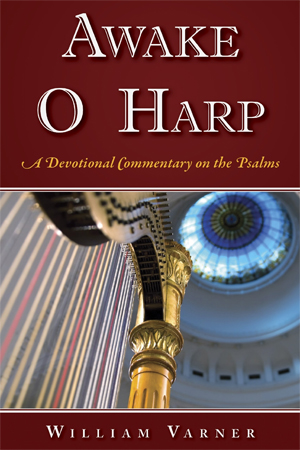This week I finished reading “Awake O Harp” by William Varner. It is a devotional commentary on the Psalms and highly instructive about the meaning and application of the ancient songs and poetry of antiquity. The book offers numerous practical thoughts about what Psalms are about and how they practically apply to us today. From an exegetically valid method of interpretation, life principles for worship, and our everyday walk are offered to prayerfully think through and bring into continued focus. I’ve learned an immense wealth of useful knowledge from this time well-spent. The book covers all 150 Psalms along with various historical and literary detail that is topical exposure for additional study (e.g. Kidner Psalms Vols 1 & 2; Estes, Handbook on the Wisdom Books and Psalms; IVP, Dictionary of the Old Testament Wisdom, Poetry & Writings). It is about 387-pages in length.
In poetic and unique literary form, the Psalms are for praise and worship meant for the accompaniment of music. It was written for ancient Israel as a collection of songs for praise in corporate worship in the temple and synagogues or personal worship as suitable. There are numerous principles at work within the book of Psalms. As a reader explores the content of the 150 chapters throughout the Old Testament text, there is a breadth and depth of meaning made evident as a unique form of genre pertaining to the value of Scripture. The Psalms appear within the New Testament further out in time from when they were individually authored eventually formed within codices down through the ages.
Scope
The Psalms are multigenerational. The Psalms span across generations from the time of Moses to down through the time of King David’s offspring and probably further out in time as numerous Psalm authorship is unknown. The genealogical reach and cultural context of the written work of Psalms are transferrable to all nationalities today who seek to praise and worship God in their native setting.
Formation
There are four types of parallelism that are within Psalms. They’re given technical names to describe the different types where it becomes easy to detect the type of poetic expression presented within a respective Psalm. Namely, these types are Synonymous, Antithetical, Synthetic, Emblematic, Formal, and Climactic Parallelism. These forms of poetry are distinct in their rhythm and formation of meaning to aid in memorization and evoke thought for contrast, reinforcement, polemics, and to drive a point home.
Structure
The structure of the various books, chapters, passages, and verses in Psalms correlate to the forms of poetic parallelism. Either as acrostics, inclusio, chiastic expressions of thought, or otherwise, each chapter is a free-standing self-evident way of worship and praise to glorify our beloved Most High. Each Psalm can be recited as a song to sing through corporate or personal worship, separate from the others without concern of contradiction or error.
Interpretation
There are various methods by which Psalms are read. They have interpretive value as a prophetic source of study, and they are thoroughly instructive for literary or grammatical understanding. They bear significant allegorical and historical weight for purposes of investigative research concerning matters of antiquity.
Categories
There are numerous categories of the Psalms by which they are recognized and ordered by their substantive meaning. Namely, Psalms fit eight specific types or categories as a reader seeks to identify how to view what an author intended. To list these Psalms, there are Pilgrimage, Wisdom, Lament, Thanksgiving, Imprecatory, Praise, Royal, and Messianic categories, where they’re grouped or collected for practical or spiritual use and application.
Authorship
While all Scripture is inspired by God, the authors of the Psalms span across numerous individuals. The perspective of individual contributions to Scripture often correlates to historical contexts that appear within Samuel, the Torah, and even the New Testament pertaining to Jesus’ life and mission. Reading these Psalms by the author given, if available, provides us an intertextual path to gain better depth about what principles apply to us today.
Theology
Generally speaking, the book of Psalms is not an extensive treatise of theological subject matter to derive a cross-section of Church doctrines. It is a compilation of relational theology between Israel and God, and for us today, between each other and before God as a matter of enduring principle.
Divisions
At a macro-level, the book of Psalms (aka the Psalter) is sub-partitioned as five separate books contained within it. Books 1 through 5 spanning through the Psalms provide to us a way of viewing and understanding Scripture as sections that correlate to the five books of the Torah. So, aside from any physical partitioning, the themes of each book offer a sectional perspective around Genesis (Book 1, Ps. 1-14), Exodus (Book 2, Ps. 42-72); Leviticus (Book 3, Ps. 73-89); Numbers (Book 4, Ps. 90-106); and Deuteronomy (Book 5, Ps. 107-150). If these divisional sections were ordered within an ancient Israelite hymnal, they might be grouped by each correlated theme. And therefore, of transferable for practical use toward worship, contemplation, benediction, or prayer today.
Prophecy
There are 23 messianic Psalms in the Old Testament written to produce prophesies up for fulfillment by the Son of God in due time. Looking back in time from what the New Testament authors wrote in the gospels, Acts, Hebrews, and Revelation, modern readers have a definitive way to validate the identity of Jesus as the Jewish Messiah and Christ over all nations. As a way to worship God for the mission of Christ, soteriological value, and the redemptive work of Jesus, one only needs to look as far as the Psalms and corresponding fulfillment many generations later as recorded in the New Testament.














Comments are closed.